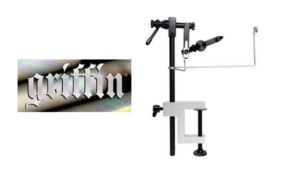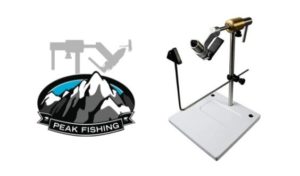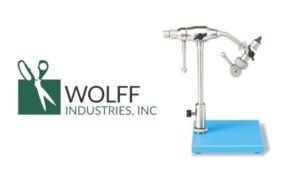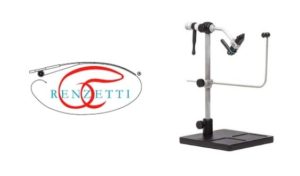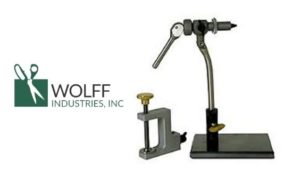Best Fly Tying Vise Reviews and Buying Guide
We purchase every product we review with our own funds — we never accept anything from product manufacturers.
Models Considered
Hours Researched
Experts Interviewed
Consumers Consulted
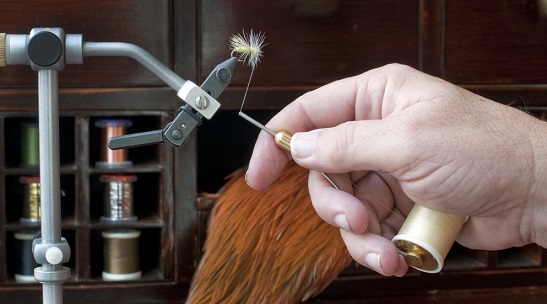
Peak is a brand that is on the rise in the fishing and sporting goods industry. This is not the prettiest looking vise you will find, especially when it is priced at over 150 dollars, but it is very simple to use.
Like the Apex vise, you can choose between c-clamp and pedestal configurations. While the c-clamp is fairly decent, more people will favor the pedestal, since it is very large in size, is reasonably stable, and makes it ideal for positioning the vise itself.
Another vise that is great for beginner fly tiers is the Spider Fly Tying Vise brought to you by Griffin.
This is a c-clamp vise only, but it offers 360 degree rotation so that you can tie flies from any angle. Clamp it to the end of your table or desk, and easily tie your flies without bending or hunching over.
You can use small to large hooks with the Spider without any problems. Working with the vise when clamped to your table is very durable, and will not move as long as you clamp it firm enough.
The Atlas vise functions very similarly to Wolff’s vise; it is made with high quality materials, looks very polished, and is built to last.
Like Griffin’s Spider vise, this also comes with a 360 degree rotation. Adjusting everything is fairly easy and has minimal resistance, despite the industrial strength steel all throughout the instrument.
The Renzetti Traveler 2200 Cam Series Vise is a great choice that can serve you for a lifetime.
The durability of materials used to make this fly tying vise are heavy-duty to say the least, allowing people to keep using this to great effect for years. Apart from that, the strength of this tool lies in its dynamic all-around usage.
This vise gets its name from a ferocious animal with a very hard and strong bite. Following from that animal, the Mongoose Griffin Montana Cam Vise has a bite that won’t let loose.
Even more interesting is the fact that the strong bite of the jaw comes in such a sleek and portable design.
Great for beginner and veteran fly tiers
Jaws are easily replaceable
Has a heavy, sturdy base for pedestal configurations
Great for beginner and veteran fly tiers
360 degree rotation offers performance at any angle
Easy to use while standing or sitting
Comes with a widely adjustable jaw
Is very affordable
360 degree rotation offers performance at any angle
Comes with a widely adjustable jaw
Remarkably strong and durable
Jaws have a nice grip
Aesthetically pleasing
Very durable
Comes with a base for working at home, but light enough to bring out
Strong grip
Highly adjustable vise
Good for various hook sizes
Changing jaws may not be what you want to be doing often
Doesn’t look all that professional
Does not come with a pedestal
Does not come with its own cradle
Lock can be overtightened if not careful
Requires some initial calibration
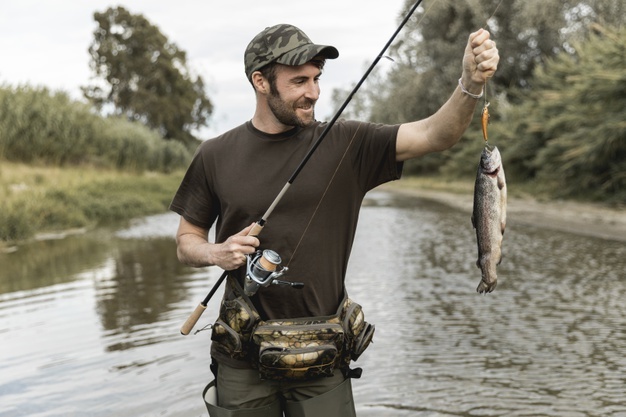
FishingLab spends thousands of hours researching, analyzing, and testing products to recommend the best picks for most consumers. We only make money if you purchase a product through our links, and we never accept free products from manufacturers
A fly tying vise is an instrument used to help aid in the process of creating fishing flies to use as tackle when you fish. These are not small or compact by any means, but they can make your fly making experience a lot better. The best fly tying vise must be sturdy, versatile, easy to use, and offers a handful of other useful features in order to make fly tying simple. Here are six fly tying vises that are ideal for fly makers and fishers alike.
Best of the best
Bottom Line
PROS
- Great for beginner and veteran fly tiers
- Jaws are easily replaceable
- Has a heavy, sturdy base for pedestal configurations
CONS
- Changing jaws may not be what you want to be doing often
- Doesn’t look all that professional
Summary
The heavy base will guarantee that you won’t jerk thread or any other parts out of place. Tying flies can be a delicate and convoluted task, and this instrument can easily help you through it from start to finish.
For a rotary vise, the rotary has amazing function and great for fishers who otherwise have a difficult time tying flies with other methods.
With Peak’s vise, you will end up having to switch between multiple different jaws on occasion, but changing jaws is fairly easy and straightforward. The range of jaws it can be attached to are phenomenal.
Best for the Price
Bottom Line
PROS
- Great for beginner and veteran fly tiers
- 360 degree rotation offers performance at any angle
- Easy to use while standing or sitting
- Comes with a widely adjustable jaw
- Is very affordable
CONS
- Does not come with a pedestal
Summary
The bobbin cradle that comes with it is adjustable and versatile, so you can place it anywhere on the vise stem and feel comfortable with tying flies while sitting or standing.
Unlike the first two vises, this vise comes with a single, adjustable jaw. This means you do not have to buy and change jaws, or be limited to smaller jaws, which is always a plus.
While priced at under $100, you are sure to get great value out of this instrument, but if pedestal vises are more your cup of tea, consider buying a pedestal or hybrid vise.
Bottom Line
PROS
- 360 degree rotation offers performance at any angle
- Comes with a widely adjustable jaw
- Remarkably strong and durable
- Jaws have a nice grip
CONS
- Does not come with its own cradle
Summary
Atlas’ vise is also compatible with attachable bobbin cradles, so that you have total control over the rotary functionality included. However, you have to buy a cradle separately. Unlike the Spider, however, this is a hybrid vise, so you can use either its c-clamp or pedestal; whichever best suits you.
The jaw is big and can be easily adjusted, albeit they can be a bit rough to use. You need to adjust the angle properly in order to get the best grip possible for gripping larger hooks.
This is a great looking clamp that will still work well in a number of years and never rust. While it costs almost 200 dollars, you can be sure it is money well spent.
Bottom Line
PROS
- Aesthetically pleasing
- Very durable
- Comes with a base for working at home, but light enough to bring out
CONS
- Lock can be overtightened if not careful
Summary
This vise is versatile, allowing anglers to use it in multiple locations. It can be used at home, but the fact that it is so light makes it great to bring it out when you travel as well.
The material used to make the body is aluminum. It gives it a very sleek and professional look. The best part is that the great aesthetic is also matched with a great performance. The grip of the jaw is strong and firm. The vise is adjustable as well, with the tips of the jaw aligning with the support arm. It offers a full 360 degrees rotation, making it easy to tie them.
Bottom Line
PROS
- Strong grip
- Highly adjustable vise
- Good for various hook sizes
CONS
- Requires some initial calibration
Summary
The sturdy grip is supplemented by an extremely adjustable vise. Multiple factors can be customized and changed such as the height and angle. Adjusting these can help anglers get a better position. At the same time, the vise smoothly rotates 360 degrees.
Purchasing this product will also give anglers a base mount and C-clamp. Both of these tools provide anglers several set up options.
Bottom Line
PROS
- Ideal for tying small flies
- Remarkably strong and durable
- Jaws have a nice grip
- Comes with two grooves for different gauges
CONS
- Jaws are small and not replaceable
- More effort must be done to use large flies
Summary
You can tie small and miniature flies with ease, thanks to its leveled head. It is both compatible with c-clamp and pedestal configurations.
https://fishinglab.net/best-fishing-hooks/One of the downsides to the Apex, however, are the jaws; they cannot be replaced or adjusted. If you want to use bigger jaws, you would have to buy an entirely different vise, because modifying this vise is not possible.
The Apex comes with two different sized grooves to accommodate different hook gauges, giving the jaws grip. But, if you use large hooks, you will have to mount the hook way back in the jaw for tying to be made easier.
Regardless, this is a very sturdy vise that will last fishers a very long time.
FAQs
By chance that you need more information for choosing fly tying and vises, here are some answers to common questions.
Is a vise an actual piece of equipment I need to take on a fishing trip?
A fly tying vise is not something that you normally take with you on a fishing trip. One or more days prior to your fishing expedition, you are to prepare your flies by using the vise to tie them in a separate location, whether it be at your home, a workshop, or another place indoors.
A fly tying vise is too heavy to take with you in your desired fishing location, and there may not be any viable locations to provide you a safe and sound fly tying experience. We strongly recommend tying flies in an safe, quiet and comfortable indoor location with a table to work at and possibly a chair for you to sit in.
What are c-clamps and pedestals? Which is better to use?
A c-clamp vise is a vise with a clamp at the bottom of it. This clamp is connected to an end, a corner, or a lip of a table or desk. A pedestal, also known as a base, is a flat surface for the vise to stand upright on. A vise with a pedestal can be placed on a table, desk, or other flat surface as you are working.
There are strengths and weaknesses for both c-clamp and pedestal vises. A c-clamp vise is fairly close to your body, so you can work on tying a fly without reaching or bending over. Because c-clamps work along the edge of the table, they occupy far less space.
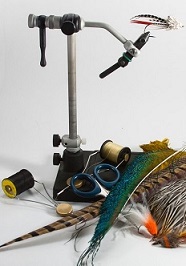
The downside is that moving a c-clamp is very hard to do, since it is clamped firmly to one part of the table. C-clamps may also be harmful to wood and other natural materials, as they can lead to eventual damage and/or discoloration.
Furthermore, it might not be possible to clamp table lips or ends on lightweight or thin tables, such as card tables.
As pedestal vises are placed on top of a surface, they can easily be moved around. Whether you want to move it closer, further away, or over to one side, the pedestal is not bound to a part of any table surface. With that being said, they will not harm wood tables or desks.
They can be placed on any surface, so if you have a table or other surface that doesn’t have a lip to clamp, you will enjoy using the pedestal more.
Pedestals and c-clamps both serve handy purposes. Which style is better, however, will overall come down to your needs and preferences.
What does jaw capacity mean?
Jaw capacity means how big enough a hook it is capable of holding. Nearly ever vise with a jaw is rated for hooks that are down to a 32.
Take into account that not only do you need a jaw that can open wide enough for your hook, but to also secure it firmly so that it cannot move or wiggle out of place.
Having a big jaw on a vise may not always be a good thing, if the hooks you are using with it are fairly loose. Jaws also have patterns to them to help grip a hook. They can be smooth, serrated, slotted, grooved or textured.
If you do not know how big you want your hooks to be, buy some normal sized hooks and make sure that the vise you want to buy is capable of firmly holding these hooks. When setting your hook into the jaw, you will want to position it as far as you can to form a tight, secure bite; yet not too far back that there is not enough room for you to work with.
Do not place your hooks in between the very tip of the jaw. This will wear out faster due to all the clamping force being dedicated to the edge.
Where can I try a fly tying vise before I buy it?
If available, you can go to a local pro shop or sporting goods store to test a fly tying vise before you make a sound decision to purchase it. There is no way to test a vise for yourself with an online store, so if you want to see a vise in action, you can search for videos, and hear what the user has to say about the vise in question to make a decision for yourself.
Final verdict on the best fly tying vise reviews
After several comparisons among all the vises in this review, we deem the best fly tying vise under $200 to be the Griffin Odyssey Spider Cam Vise.
For being smack dab in the middle of the price range for vises, the Spider Cam has almost everything you want in a good vise. It has great quality, it is stable, it has a large enough jaw, and you can adjust it easily to best accommodate your desk or table.
While there are other vises that have remarkable quality and cost more, they are not the most functional. While it is true that the Spider Cam is does not have a pedestal, you can always give it one if you cannot grow accustomed to its c-clamp.
Whether you are new to fly tying or simply want to find a better way to tie, you simply cannot go wrong with the Spider Cam.
We like to share product recommendations with you and hope you like them! Just to make you aware FishingLab may collect a small share of sales or other compensation from the links on this page.

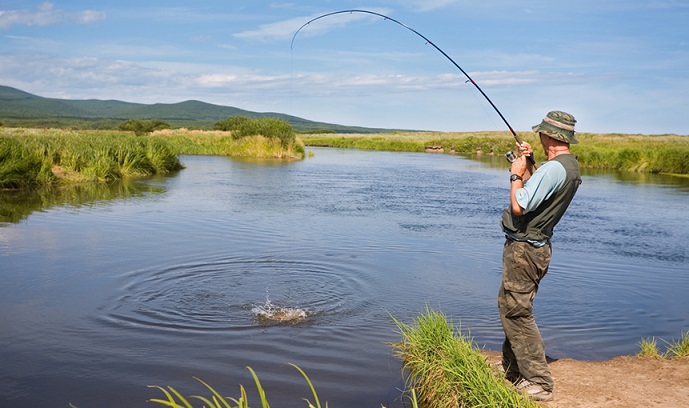
Article Name
Best Fly Tying Vise Reviews And Buying Guide 2020
We like to share product recommendations with you and hope you like them! Just to make you aware FishingLab may collect a small share of sales or other compensation from the links on this page.

